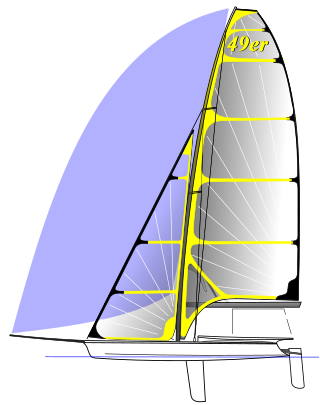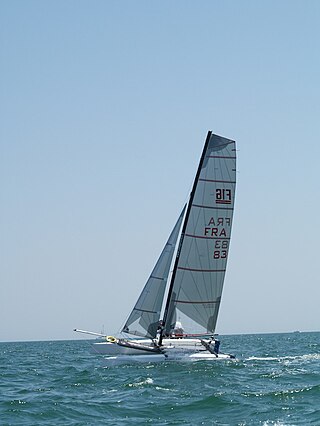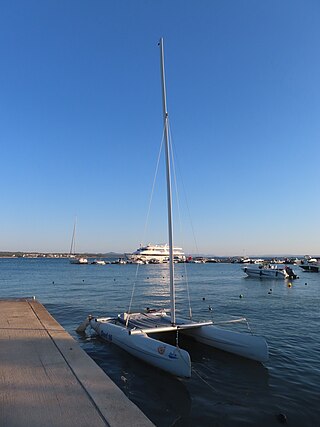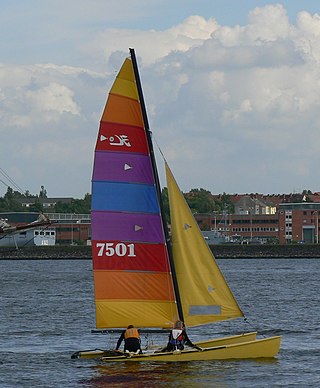
A sailboat or sailing boat is a boat propelled partly or entirely by sails and is smaller than a sailing ship. Distinctions in what constitutes a sailing boat and ship vary by region and maritime culture.

The 49er and 49er FX is a two-handed skiff-type high-performance sailing dinghy. The two crew work on different roles with the helm making many tactical decisions, as well as steering, and the crew doing most of the sail control. Both of the crew are equipped with their own trapeze and sailing is done while cantilevered over the water to the fullest extent to balance against the sails.

Hobie Cat is a company that manufactures watercraft as the Hobie Cat Company. "Hobie Cat" can also refer to specific products of the company, notably its sailing catamarans. Its fiberglass catamaran models range in nominal length between 14 feet (4.3 m) and 18 feet (5.5 m). Rotomolded catamaran models range in length between 12 feet (3.7 m) and 17 feet (5.2 m). Other sailing vessels in the Hobie Cat lineup include, monocats, dinghies, and trimarans, ranging in length between 9 feet (2.7 m) and 20 feet (6.1 m). Its largest product was the Hobie 33, 33 feet (10 m) in length. The company's non-sailing product line includes surfboards, kayaks, stand-up paddle boards, and pedalboards. It was founded in 1961 by Hobart (Hobie) Alter, who originally manufactured surfboards.

The Formula 16 (F16) sport catamaran is an ISAF recognised 5 m long beach catamaran with an asymmetric spinnaker setup.

A sailing hydrofoil, hydrofoil sailboat, or hydrosail is a sailboat with wing-like foils mounted under the hull. As the craft increases its speed the hydrofoils lift the hull up and out of the water, greatly reducing wetted area, resulting in decreased drag and increased speed. A sailing hydrofoil can achieve speeds exceeding double and in some cases triple the wind speed.
The Dart 18 is a one-design 18-foot (5.5 m) long glassfibre sailing catamaran. It is designed to be sailed by two people and can achieve speeds of up to 20 knots. This is reflected in its Portsmouth Yardstick of 805 and D-PN of 76.3

The Topcat is a one-design sailing catamaran boat class which is divided into several boat sizes.

The Dart 16 is a one-design 4.80 m long sailing catamaran. It is designed to be sailed by two people. It races off a Portsmouth Yardstick of 863.

The Hobie Tiger or Hobie Tiger 18, is a French catamaran sailboat that was designed by Hobie Cat Europe as a Formula 18 racer and first built in 1995.

The Hobie Getaway is an American catamaran sailboat, that was designed by Hobie Cat and first built in 2001.

The Hobie Wave is an American catamaran that was designed by Morrelli & Melvin and first built in 1994.

The Hobie Bravo is an American catamaran sailing dinghy that was designed by Hobie Cat in 2000 and first built in 2001. The design is intended for sailing from beaches by one or two people.

The Hobie 17 is an American catamaran that was designed by John Wake as a single-handed racer and first built in 1985.

The Hobie 14 is an American catamaran sailing dinghy that was designed by Hobie Alter and first built in 1967.
The Trac 14 is an American catamaran sailing dinghy that was designed by Australians Richard McFarlane and Jay McFarlane as a one-design racer and first built in 1980.
The Nacra 5.2 is an American catamaran sailing dinghy that was designed by Tom Roland as a one-design racer and first built in 1975. Other than the small production run Nacra 36, the Nacra 5.2 was the first Nacra brand boat and established its reputation.
The Isotope is an American catamaran sailing dinghy that was designed by Frank Meldau as a one-design racer and first built in 1962.
The Prindle 18 is an American catamaran sailing dinghy that was designed by Geoffrey Prindle as a racer and first built in 1977.

The Hobie 18 is an American catamaran sailboat that was designed by Hobie Alter and Phil Edwards as a one design racer and first built in 1976.

The Nacra F16 is a Dutch catamaran sailing dinghy that was designed by Americans Morrelli and Melvin as a one-design Formula 16 racer and first built in 2011.

















